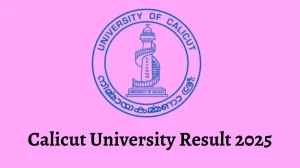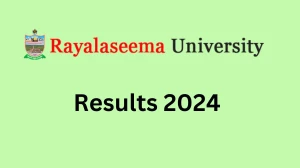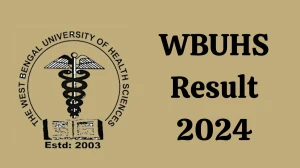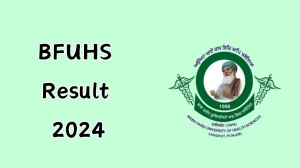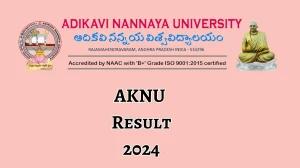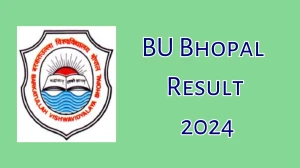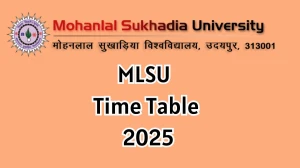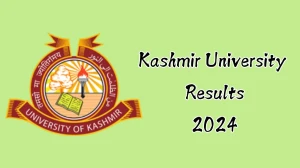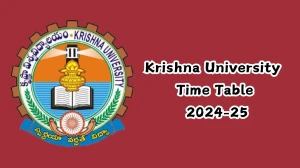- Rojgarlive »
- Education »
- IIT JAM Syllabus 2024 at jam.iitm.ac.in Check and Download Here
IIT JAM Syllabus 2024 at jam.iitm.ac.in Check and Download Here
by Keerthika
Updated Aug 01, 2024
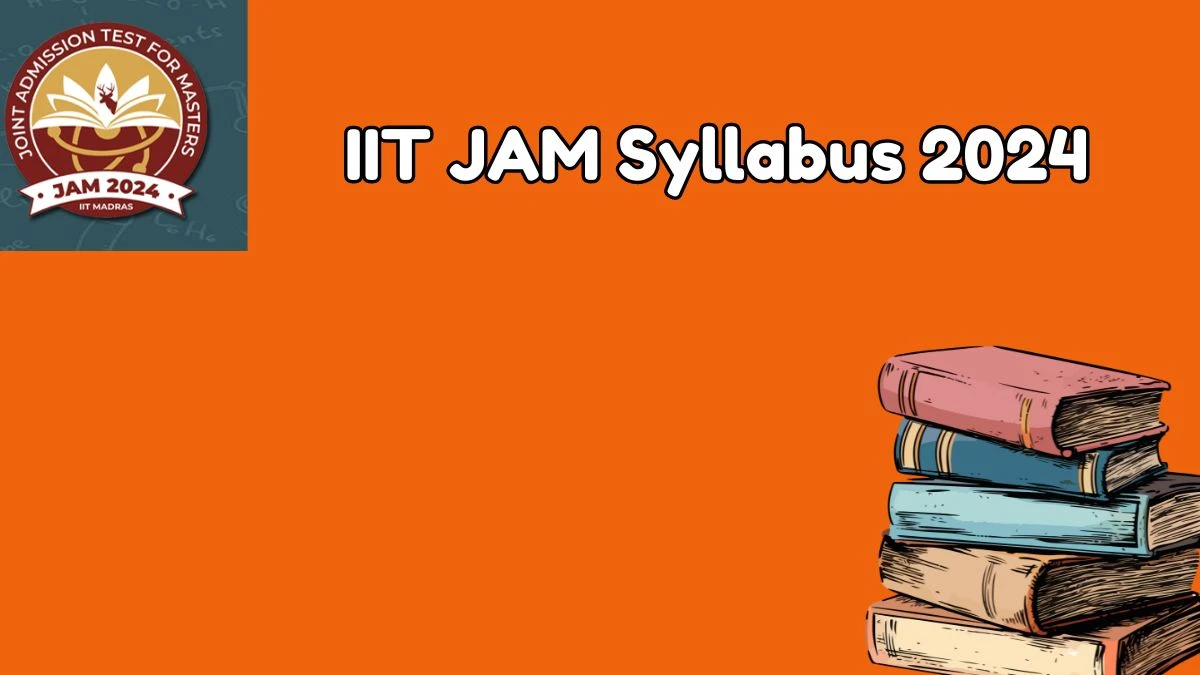
IIT JAM Syllabus 2024
The Indian Institute of Technology (IIT) Madras has released the IIT JAM 2024 syllabus on its official website. Candidates preparing for the IIT JAM exam should review the exam syllabus carefully. The syllabus, which includes 7 subjects—Economics, Mathematical Statistics, Biotechnology, Mathematics, Chemistry, Geology, and Physics—can be downloaded as a PDF from the official website. To begin preparing for JAM 2024, candidates should familiarize themselves with the syllabus. The question paper will include questions based on this syllabus. For detailed information about the IIT JAM 2024 syllabus and subject-wise content, please refer to the following article.
Check - IIT JAM Syllabus 2024
IIT JAM Biotechnology Syllabus 2024
The biotechnology test paper will consists of four subjects such as Biology, Chemistry, Physics and Mathematics. Candidates Candidates can check the IIT JAM biotechnology syllabus pdf from the below table.
|
Subject |
Topic |
Subtopics |
|
Biology (10+2+3 level) |
General Biology |
Taxonomy, Heredity, Genetic variation, Conservation, Principles of ecology, Evolution, Techniques in modern biology. |
|
Biochemistry and Physiology |
Carbohydrates, Proteins, Lipids, Nucleic acids, Enzymes, Vitamins, Hormones, Metabolism (Glycolysis, TCA cycle, Oxidative Phosphorylation, Photosynthesis), Nitrogen Fixation, Fertilization and Osmoregulation, Vertebrates-Nervous system, Endocrine system, Vascular system, Immune system, Digestive system and Reproductive System. |
|
|
Basic Biotechnology |
Tissue culture, Application of enzymes, Antigen-antibody interaction, Antibody production, Diagnostic aids. |
|
|
Molecular Biology |
DNA, RNA, Replication, Transcription, Translation, Proteins, Lipids and Membranes, Operon model, Gene transfer. |
|
|
Cell Biology |
Cell cycle, Cytoskeletal elements, Mitochondria, Endoplasmic reticulum, Chloroplast, Golgi apparatus, Signalling. |
|
|
Microbiology |
Isolation, Cultivation, Structural features of virus, Bacteria, Fungi, Protozoa, Pathogenic microorganisms. |
|
|
Chemistry (10+2+3 level) |
Atomic Structure |
Bohr’s theory and Schrodinger wave equation, Periodicity in properties, Chemical bonding, Properties of s, p, d and f block elements, Complex formation, Coordination compounds, Chemical equilibrium, Chemical thermodynamics (first and second law); Chemical kinetics (zero, first, second and third-order reactions), Photochemistry, Electrochemistry, Acid-base concepts, Stereochemistry of carbon compounds, Inductive, electrometric, conjugative effects and resonance. |
|
|
Chemistry of Functional Groups |
Hydrocarbons, alkyl halides, alcohols, aldehydes, ketones, carboxylic acids, amines and their derivatives, Aromatic hydrocarbons, halides, nitro and amino compounds, phenols, diazonium salts, carboxylic and sulphonic acids, Mechanism of organic reactions. |
|
|
Synthetic polymers |
Biomolecules, amino acids, proteins, nucleic acids, lipids and carbohydrates (polysaccharides), Instrumental techniques – chromatography (TLC, HPLC), electrophoresis, UV-Vis, IR and NMR spectroscopy, mass spectrometry |
|
Mathematics (10+2 level)
|
|
Sets, Relations and Functions, Mathematical Induction, Logarithms, Complex numbers, Linear and Quadratic equations, Sequences and Series, Trigonometry, Cartesian System of Rectangular Coordi-nates, Straight lines and Family, Circles, Conic Sections, Permutations and Combinations, Binomial Theorem, Exponential and Logarithmic Series, Mathematical Logic, Statistics, Three Dimensional, Geometry, Vectors, Matrices and Determinants, Boolean Algebra, Probability, Functions, limits and Continuity, Differentiation, Application of Derivatives, Definite and Indefinite Integrals, Differential Equations.
|
|
Physics (10+2 level) |
|
Physical World and Measurement, Elementary Statics and Dynamics, Kinematics, Laws of Motion, Work, Energy and Power, Electrostatics, Current electricity, Magnetic Effects of Current and Magne-tism, Electromagnetic Induction and Alternating Current, Electromagnetic waves, Optics, Dual Na-ture of Matter and Radiations, Atomic Nucleus, Solids and Semiconductor Devices, Principles of Communication, Motion of System of Particles and Rigid Body, Gravitation, Mechanics of Solids and Fluids, Heat and Thermodynamics, Oscillations, Waves |
IIT JAM Chemistry Syllabus 2024
The IIT JAM 2024 syllabus chemistry pdf will be available on the official website. The JAM 2024 syllabus chemistry will consist of physical chemistry, organic chemistry and inorganic chemistry. Candidates can check the IIT JAM syllabus chemistry from the below table.
|
Units |
Topics |
|---|---|
|
Physical Chemistry |
|
|
Basic Mathematical Concepts |
Functions, Maxima and Minima, Integrals, Ordinary Differential Equations, Vectors and Matrices, Determinants, Elementary Statistics and Probability Theory |
|
Atomic and Molecular Structure |
Fundamental Particles, Bohr’s Theory of Hydrogen-like Atom, Wave-Particle Duality, Uncertainty Principle, Schrödinger’s Wave Equation, Quantum Numbers, Shapes of Orbitals, Hund’s Rule and Pauli’s Exclusion Principle, Electronic Configuration of Simple Homonuclear Diatomic Molecules |
|
Theory of Gases |
Equation of State for Ideal and Non-Ideal (Van Der Waals) Gases, Kinetic Theory of Gases, Maxwell-Boltzmann Distribution Law, Equipartition of Energy. |
|
Solid state |
Crystals and Crystal Systems, X-rays, NaCl and KCl Structures, Close Packing, Atomic and Ionic Radii, Radius Ratio Rules, Lattice Energy, Born-Haber Cycle, Isomorphism, Heat Capacity of Solids. |
|
Chemical Thermodynamics |
Reversible and Irreversible Processes, First Law and Its Application to Ideal and Nonideal Gases, Thermochemistry, Second Law, Entropy and Free Energy, Criteria for Spontaneity. |
|
Chemical and Phase Equilibria |
Law of Mass Action, Kp, Kc, Kx and Kn, Effect of Temperature on K, Ionic Equilibria in Solutions, PH and Buffer Solutions, Hydrolysis, Solubility Product, Phase Equilibria–Phase Rule and its Application to One-Component and Two-Component Systems, Colligative Properties |
|
Electrochemistry |
Conductance and its Applications, Transport Number, Galvanic cells, EMF and Free Energy, Concentration Cells with and without Transport, Polarography, Concentration cells with and without Transport, Debye-Huckel-Onsager Theory of Strong Electrolytes, Chemical Kinetics, Reactions of Various Order, Arrhenius Equation, Collision Theory, Transition State Theory, Chain Reactions – Normal and Branched, Enzyme Kinetics, Photochemical Processes, Catalysis. |
|
Adsorption |
Gibbs Adsorption Equation, Adsorption Isotherm, Types of Adsorption, Surface Area of Adsorbents, Surface Films on Liquids. |
|
Spectroscopy |
Beer-Lambert Law, Fundamental Concepts of Rotational, Vibrational, Electronic and Magnetic Resonance Spectroscopy. |
|
Organic Chemistry |
|
|
Basic Concepts in Organic Chemistry and Stereochemistry |
Electronic Effects (Resonance, Inductive, Hyperconjugation) and Steric Effects and its Applications (Acid/Base Property), Optical Isomerism in Compounds with and without any Stereocenters (Allenes, Biphenyls), Conformation of Acyclic Systems (Substituted Ethane/n-Propane/n-Butane) and Cyclic Systems (Mono- and Di-Substituted Cyclohexanes). |
|
Organic Reaction Mechanism and Synthetic Applications |
Dozens Reaction, Wittig Reaction and McMurry Reaction, Pinacol-Pinacolone, Favorskii, Benzilic Acid Rearrangement, Dienone-Phenol Rearrangement, Baeyer-Villiger Reaction, Oxidation and Reduction Reactions in Organic Chemistry, Organometallic Reagents in Organic Synthesis (Grignard, Organolithium and Organocopper), Diels-Alder, Electrocyclic and Sigmatropic Reactions, Functional Group Interconversions and Structural Problems using Chemical Reactions, Chemistry of Reactive Intermediates (Carbocations, Carbanions, Free Radicals, Carbenes, Nitrenes, Benzynes etc…), Hofmann-Curtius-Lossen Rearrangement, Wolff Rearrangement, Simmons-Smith Reaction, Reimer-Tiemann Reaction, Michael Reaction. |
|
Qualitative Organic Analysis |
Identification of Functional Groups by Chemical Tests, Elementary UV, IR and 1H NMR Spectroscopic Techniques as Tools for Structural Elucidation |
|
Natural Products Chemistry |
Chemistry of Alkaloids, steroids, Terpenes, Carbohydrates, Amino Acids, Peptides and Nucleic Acids. |
|
Aromatic and Heterocyclic Chemistry |
Monocyclic, Bicyclic and Tricyclic Aromatic Hydrocarbons, and Monocyclic Compounds with One Hetero Atom, Synthesis, Reactivity, and Properties. |
|
Inorganic Chemistry |
|
|
Main Group Elements (s and p blocks) |
General concepts on Group Relationships and Gradation in Properties, Structure of Electron Deficient Compounds involving Main Group Elements |
|
Periodic Table |
Periodic Classification of Elements and Periodicity in Properties, General Methods of Isolation and Purification of Elements, Chemical Bonding and Shapes of Compounds, Types of Bonding, VSEPR Theory and Shapes of Molecules, Hybridization, Dipole Moment, Ionic Solids, Structure of NaCl, CsCl, Diamond and Graphite, Lattice Energy |
|
Bioinorganic Chemistry |
Essentials and Trace Elements of Life, Basic Reactions in Biological Systems and the Role of Metal Ions, especially Fe2+, Fe3+, Cu2+ and Zn2+, Structure and Function of Hemoglobin and Myoglobin and Carbonic Anhydrase. |
|
Transition Metals (d block) |
Characteristics of 3d Elements, Oxide, Hydroxide and Salts of First Row Metals, Coordination Complexes, Structure, Isomerism, Reaction Mechanism and Electronic Spectra, VB, MO and Crystal Field Theoretical Approaches for Structure, Color and Magnetic Properties of Metal Complexes, Organometallic Compounds having Ligands with Back Bonding Capabilities such as Metal Carbonyls, Carbenes, Nitrosyls and Metallocenes, Homogeneous Catalysis. |
|
Instrumental Methods of Analysis |
Essentials and Trace Elements of Life, Basic Reactions in Biological Systems and the Role of Metal Ions, especially Fe2+, Fe3+, Cu2+ and Zn2+, Structure and Function of Hemoglobin and Myoglobin and Carbonic Anhydrase. |
|
Analytical Chemistry |
Principles of Qualitative and Quantitative Analysis, Acid-Base, Oxidation-Reduction and Complexometric Titrations using EDTA, Precipitation Reactions, Use of Indicators, Use of Organic Reagents in Inorganic Analysis, Radioactivity, Nuclear Reactions, Applications of Isotopes. |
IIT JAM Geology Syllabus 2024
The syllabus of IIT JAM for Geology will consists of many topics such as planet earth, geomorphology and many more. Aspirants can go through the table below for the IIT JAM Geology syllabus.
|
IIT JAM Geology 2024 Syllabus |
Subtopics |
|
The Planet Earth |
Origin of the Solar System and the Earth; Geosphere and Earth’s composition; Shape and size of the earth; Earth-moon system. Apart from that Formation of continents and oceans; Dating rocks along with the age of the Earth; details of Volcanism and volcanic landforms; Interior of the earth; Earthquakes; Earth’s magnetism and gravity, Isostasy; Elements of Plate tectonics; Orogenic cycles, etc. |
|
Geomorphology |
Weathering and erosion; Transportation and deposition because of wind, ice, river, sea, and resulting landforms, Contractually controlled landforms, etc. |
|
Structural Geology |
Concept of stratum; Contour; Outcrop patterns; details of Maps and cross sections; Dip and strike. Also, there are Classification and origin of folds, faults, joints, unconformities, foliations and lineation, shear zones. It also includes Stereographic and equal area projections of planes and lines; computation of true thickness of beds from outcrops and bore-holes, etc. |
|
Palaeontology |
Evolution of life forms; Fossils and their way of preservation and utility; Morphological characters, major evolutionary trends as well as different ages of animal groups such as Brachiopoda, Mollusca, Trilobita, Graptoloidea, Anthozoa, Echinodermata, etc. It also covers Gondwana plant fossils along with the primary idea of vertebrate fossils only in India. |
|
Stratigraphy |
Stratigraphy; classification of Litho-, chrono- and biostratigraphy; distribution and classification of the stratigraphic horizons of India from Archaean to Recent, etc |
|
Mineralogy |
Symmetry and all kinds of forms in common crystal classes; details of Physical properties of minerals; Isomorphism and polymorphism, Classification of minerals; Structure of silicates. Besides that, Mineralogy of some of the most customary rock-forming minerals; Mode of occurrence of minerals in rocks. Transmitted polarized light microscopy and optical properties of uniaxial and biaxial minerals are also included. |
|
Petrology |
Classification of all the areas are rocks; Igneous rocks-forms of igneous bodies; Crystallization from magma; association and genesis of igneous rocks; Sedimentary rocks –texture, structure, and others; size and shape of sedimentary bodies. Metamorphic rock covering facies, zones, and texture. Characteristic mineral assemblages of pelites in the Barrovian zones and mafic rocks in common facies, etc |
|
Economic Geology |
Properties of common economic minerals; common or normal processes of mineral deposit’s formation; Physical characters; Mode of development and dispensation of metallic as well as for non-metallic mineral deposits in India; Coal and petroleum occurrences in India. |
|
Applied Geology |
Groundwater; Principles of Engineering Geology, etc. |
IIT JAM Mathematics Syllabus 2024
The mathematics syllabus consists of four chapters for IIT JAM. Candidates can go through the below table for IIT JAM syllabus mathematics to get an idea of the topics.
|
Topic |
Subtopics |
|
Sequences and Series of Real Numbers |
Sequence of real numbers, the convergence of sequences, bounded and monotone sequences, convergence criteria for sequences of real numbers. Apart from that, there are Cauchy sequences and subsequences, Bolzano-Weierstrass theorem. Also, there are Series of real numbers, absolute convergence, tests of convergence for series of positive terms that includes comparison test, ratio test, root test and also Leibniz test for convergence of alternating series, etc. |
|
Differential Equations |
Ordinary differential equations of the first order of the form y'=f (x,y), Bernoulli’s equation, exact differential equations, integrating factor, orthogonal trajectories, homogeneous differential equations. There are also various separable equations along with linear differential equations that are only for second order with constant coefficients. And also, the Method of variation of parameters, Cauchy-Euler equation is there. |
|
Integral Calculus |
Integration that is defined as the inverse process of differentiation along with definite integrals, and all the properties with the fundamental theorem of calculus. Besides that, there are Double and triple integrals, details on change of order of integration, the process to calculate surface areas and volumes with the help of double integrals and also includes calculating volumes with the help of triple integrals. |
|
Linear Algebra |
Finite dimensional vector spaces along with linear independence of vectors, its basis and dimension, linear transformations, details on matrix representation and also range space with null space, concepts on rank-nullity theorem. It also covers Rank and inverse of a matrix, determinant and all the solutions of linear equation’s systems. On the contrary there are consistency conditions along with eigenvalues, and also eigenvectors for matrices, Cayley-Hamilton theorem, etc in this section. |
IIT JAM Physics Syllabus 2024
The IIT JAM 2024 physics syllabus consists of mathematical methods, oscillations, waves and optics and many more. To get detailed information about the IIT JAM syllabus physics go through the below table.
|
Units |
Topics/ Subtopics |
|
Mathematical Methods |
Calculus of Single and Multiple Variables, Taylor Expansion, Partial Derivatives, Jacobian, Fourier Series, Imperfect and Perfect Differentials, Vector Algebra, Vector Calculus, Multiple Integrals, Green's Theorem, Divergence Theorem, Stokes' Theorem, Matrices and Determinants, Algebra of Complex Numbers, First Order Equations and Linear Second Order Differential Equations with Constant Coefficients |
|
Mechanics and General Properties of Matter |
Velocity and Acceleration in Cartesian, Centrifugal and Coriolis Forces, Uniformly Rotating Frame, Kepler's Laws, Motion under a Central Force, Newton's Laws of Motion and Applications, Polar and Cylindrical Coordinate Systems, Gravitational Law and Field, Conservative and Non-Conservative Forces. Equation of Motion of the CM System of Particles, Center of Mass, Conservation of Linear and Angular Momentum, Elastic and Inelastic Collisions. Conservation of Energy, Variable Mass Systems. |
|
Oscillations, Waves and Optics |
Superposition of two or more Simple Harmonic Oscillators, Differential Equation for Simple Harmonic Oscillator and its General Solution, Damped and Forced Oscillators, Resonance, Lissajous Figures, Energy Density and Energy Transmission in Waves, Wave Equation, Traveling and Standing Waves in One-Dimension, Doppler Effect, Fermat's Principle, Group Velocity and Phase Velocity. Sound Waves in Media |
|
Electricity and Magnetism |
Superposition of two or more Simple Harmonic Oscillators, Differential Equation for Simple Harmonic Oscillator and its General Solution, Damped and Forced Oscillators, Resonance, Lissajous Figures, Energy Density and Energy Transmission in Waves, Wave Equation, Traveling and Standing Waves in One-Dimension, Doppler Effect, Fermat's Principle, Group Velocity and Phase Velocity. Sound Waves in Media |
|
Kinetic theory, Thermodynamics |
Elements of Kinetic Theory of Gases, Specific Heat of Mono-, Di- and Triatomic Gases, Velocity Distribution and Equipartition of Energy, Ideal Gas, Van-Der-Waals Gas and Equation of State, Mean Free Path, Carnot Cycle, Zeroth Law and Concept of Thermal Equilibrium, Reversible, Irreversible and Quasi-Static Processes, First Law and its Consequences, Second Law and Entropy, Laws of Thermodynamics, Isothermal and Adiabatic Processes |
|
Modern Physics |
Postulates of Special Relativity. Lorentz Transformations. Inertial Frames and Galilean Invariance, Time Dilation, Length Contraction, Relativistic Velocity Addition Theorem, Mass Energy Equivalence, Blackbody Radiation, Photoelectric Effect, Compton Effect, Bohr's Atomic Model, X-rays. |
|
Solid State Physics, Devices and Electronics |
Crystal Structure, Miller Indices. X-Ray Diffraction and Bragg's Law, Bravais Lattices and Basis, Intrinsic and Extrinsic Semiconductors, Variation of Resistivity with Temperature, Fermi Level. P-N Junction Diode, I-V Characteristics, BJT, Characteristics in CB, CE, CC Modes, Zener Diode and its Applications. |
IIT JAM Mathematical Statistics Syllabus 2024
Candidates can check the IIT JAM mathematical statistics syllabus from the below table which consists of topics and subtopics.
|
Subject |
Topic |
Subtopic |
|
Mathematics |
Differential Calculus |
Limits, Continuity and differentiability of functions of one and two variables. Rolle's theorem, Mean value theorems, Taylor's theorem, Indeterminate forms, Maxima and Minima of functions of one and two variables. |
|
Sequences and Series |
Convergence of sequences of real numbers, Comparison, root and ratio tests for convergence of series of real numbers. |
|
|
Matrices |
Rank, inverse of a matrix. Systems of linear equations. Linear transformations, eigenvalues and eigenvectors. Cayley-Hamilton theorem, symmetric, skew-symmetric and orthogonal matrices. |
|
|
Integral Calculus |
Fundamental theorems of integral calculus. Double and triple integrals, applications of definite integrals, arc lengths, areas and volumes. |
|
|
Statistics |
Random Variables |
Probability mass function, probability density function and cumulative distribution functions, distribution of a function of a random variable. Mathematical expectation, moments and moment generating function. Chebyshev's inequality. |
|
Standard Distributions |
Binomial, negative binomial, geometric, Poisson, hypergeometric, uniform, exponential, gamma, beta and normal distributions. Poisson and normal approximations of a binomial distribution. |
|
|
Probability |
Axiomatic definition of probability and properties, conditional probability, multiplication rule. Theorem of total probability. Bayes’ theorem and independence of events. |
|
|
Joint Distributions |
Marginal and conditional distributions, Joint, Distribution of functions of random variables. Joint moment generating function. Product moments, correlation, Simple linear regression. Independence of random variables. |
|
|
Limit Theorems |
Weak law of large numbers. Central limit theorem (i.i.d.with finite variance case only). |
|
|
Testing of Hypotheses |
Basic concepts, Applications of Neyman-Pearson Lemma for testing simple and composite hypotheses. Likelihood ratio tests for parameters of univariate normal distribution. |
|
|
Estimation |
Unbiasedness, Consistency and efficiency of estimators, Method of moments and method of maximum likelihood. Sufficiency, Factorization theorem. Completeness, Rao-Blackwell and Lehmann-Scheffe theorems, Uniformly minimum variance unbiased estimators. Rao-Cramer inequality. Confidence intervals for the parameters of univariate normal, Two independent normal, and one parameter exponential distributions. |
|
|
Sampling distribution |
Chi-square, t and F distributions, and their properties. |
IIT JAM Syllabus 2024? -FAQ
Candidates can download the IIT JAM 2024 syllabus by visiting the official website - jam.iitm.ac.in.
Yes, candidates can take IIT JAM in two subjects, but one must ensure that both the subjects are not scheduled in the same session

